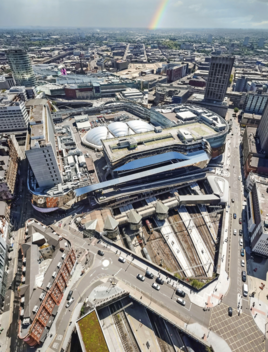In the 1950s, if you walked north along Temple Street past St Philip’s Cathedral from Birmingham New Street to Snow Hill stations, you would be swapping a world of maroon signs for one of brown.
British Railways ran both stations and their branding had the same typeface, but their background colours differed according to the region within which the station lay.
Brown denoted the Western Region - chiefly those lines inherited at nationalisation in 1948 from the Great Western Railway. Maroon was the London Midland Region’s colour and its lines came mainly from the former London, Midland and Scottish Railway. Southern Region used green, with an area that comprised the old Southern Railway routes, while the Eastern Region used dark blue for what had been the London and North Eastern Railway from Doncaster southwards. The old LNER north of Doncaster became the North Eastern Region and adopted an orange-tangerine colour.
Nationalisation gave Scotland its own railway. With its light blue colour, it took lines from the LMS and LNER north of the border.
Thus, the unified BR split itself into six regions (later five when the NE Region folded into the Eastern Region). The differences gave some regional pride and hinted that nothing had changed when everything had changed. Eventually, the regional colours gave way to a single BR brand, with the double-arrow symbol that endures today, a new typeface (Rail Alphabet), and rolling stock colours dominated by blue.
Behind this increasing uniformity still stood the regional structure. Railway economic historian Terry Gourvish notes in British Rail 1974-97: “The linchpin of the basic railway was the multi-functional region, led by a regional general manager… The regions consisted of functional departments concerned with marketing, operations, engineering, finance, investment and personnel, all of which were replicated at headquarters. The general managers had complete control of nearly all the functions and activities within their geographic area, but because these boundaries did not coincide with the markets served, financial responsibility was very limited below Board level, engineering and ‘traffic’ managers were dominant, and the only person whose responsibilities embraced both costs and revenue was the Chief Executive (Railways).
“The situation followed on from the method of management accounting used. Although revenue and cost elements frequently crossed regional boundaries, an ‘originating’ basis was used whereby revenue was recorded and credited at the point of collection and costs were charged to the originating region.”
Gourvish is summarising the early 1980s, as BR and government continued their search for financial nirvana, which presaged the creation of rail sectors based on traffic rather than geography. These sectors were Inter-City, Provincial, London and South Eastern, Railfreight and Parcels. There followed debate about how to allocate costs to each sector, with decisions here making the difference between a sector being seen as profitable or not.
Jump forward into the 1990s, and those sectors have been further refined into smaller units fit for privatisation in the form of train operating franchises (with Railfreight split and sold outright).
Railtrack took over BR’s infrastructure before government sold it in 1996. It depended on income from operators (passenger and freight), with the Office of the Rail Regulator created to decide what charges those operators should pay.
Ideally, operators would pay all Railtrack’s costs and contribute to its investment funding. In reality, government never escaped the need to subsidise some rail operations and infrastructure costs. It paid this initially through train operators, before an outcry over these private operators receiving money made it shift to directly funding most of the infrastructure operator’s needs.
Today, that infrastructure operator is Network Rail and it’s still receiving hefty government grants.
Before the pandemic, the train operators were nominally making a profit. But when accountants added their share of NR’s grant to the overall equation, it emerged that only two covered their full costs - Intercity East Coast (LNER today) and South Western commuter services (South Western Railway today). Towards the end of the 2010s, the Department for Transport was receiving more in premium payments from some train operators than it was paying in subsidies to other operators, but this surplus was dwarfed by payments to NR.
Today’s private operators run under a panoply of colours about as far removed from Rail Blue as it’s possible to be. For the blue purist, the rot set in with sectorisation. It let dynamic managers such as Chris Green create ScotRail’s brand, before moving south with a can of red paint to create Network SouthEast from the London and South East sector. His revolution brought branding across stations, trains and publicity. Similar happened with InterCity, while Provincial became Regional Railways.
Yet Provincial faced a branding rival, and that was the Passenger Transport Executives created by government in 1974. There were seven based on major conurbations - Strathclyde, Tyne and Wear, West Yorkshire, South Yorkshire, Greater Manchester, Merseyside and the West Midlands. They developed strong branding, and their effect was more than skin deep because they also provided money to invest in rail.
In the West Midlands, the PTE (branded Centro but sometimes cruelly labelled ‘Wumpty’) invested to reopen the Snow Hill-Smethwick line and contributed towards the cross-city electrification project.
Greater Manchester provided almost half the money needed to build a link to Manchester Airport, while West Yorkshire funded a substantial part of the electrification project from Leeds out to Skipton, Ilkley and Bradford Forster Square. Strathclyde PTE opened a score of stations around Glasgow.












